Mauro Dalla Mura
GIPSA-SIGMAPHY
Augmented Invertible Koopman Autoencoder for long-term time series forecasting
Mar 17, 2025Abstract:Following the introduction of Dynamic Mode Decomposition and its numerous extensions, many neural autoencoder-based implementations of the Koopman operator have recently been proposed. This class of methods appears to be of interest for modeling dynamical systems, either through direct long-term prediction of the evolution of the state or as a powerful embedding for downstream methods. In particular, a recent line of work has developed invertible Koopman autoencoders (IKAEs), which provide an exact reconstruction of the input state thanks to their analytically invertible encoder, based on coupling layer normalizing flow models. We identify that the conservation of the dimension imposed by the normalizing flows is a limitation for the IKAE models, and thus we propose to augment the latent state with a second, non-invertible encoder network. This results in our new model: the Augmented Invertible Koopman AutoEncoder (AIKAE). We demonstrate the relevance of the AIKAE through a series of long-term time series forecasting experiments, on satellite image time series as well as on a benchmark involving predictions based on a large lookback window of observations.
Multiple-beam Interference Spectroscopy: Instrument Analysis and Spectrum Reconstruction
Oct 28, 2024Abstract:Hyperspectral imaging systems based on multiple-beam interference (MBI), such as Fabry-Perot interferometry, are attracting interest due to their compact design, high throughput, and fine resolution. Unlike dispersive devices, which measure spectra directly, the desired spectra in interferometric systems are reconstructed from measured interferograms. Although the response of MBI devices is modeled by the Airy function, existing reconstruction techniques are often limited to Fourier-transform spectroscopy, which is tailored for two-beam interference (TBI). These methods impose limitations for MBI and are susceptible to non-idealities like irregular sampling and noise, highlighting the need for an in-depth numerical framework. To fill this gap, we propose a rigorous taxonomy of the TBI and MBI instrument description and propose a unified Bayesian formulation which both embeds the description of existing literature works and adds some of the real-world non-idealities of the acquisition process. Under this framework, we provide a comprehensive review of spectroscopy forward and inverse models. In the forward model, we propose a thorough analysis of the discretization of the continuous model and the ill-posedness of the problem. In the inverse model, we extend the range of existing solutions for spectrum reconstruction, framing them as an optimization problem. Specifically, we provide a progressive comparative analysis of reconstruction methods from more specific to more general scenarios, up to employing the proposed Bayesian framework with prior knowledge, such as sparsity constraints. Experiments on simulated and real data demonstrate the framework's flexibility and noise robustness. The code is available at https://github.com/mhmdjouni/inverspyctrometry.
Denoising of Geodetic Time Series Using Spatiotemporal Graph Neural Networks: Application to Slow Slip Event Extraction
May 06, 2024Abstract:Geospatial data has been transformative for the monitoring of the Earth, yet, as in the case of (geo)physical monitoring, the measurements can have variable spatial and temporal sampling and may be associated with a significant level of perturbations degrading the signal quality. Denoising geospatial data is, therefore, essential, yet often challenging because the observations may comprise noise coming from different origins, including both environmental signals and instrumental artifacts, which are spatially and temporally correlated, thus hard to disentangle. This study addresses the denoising of multivariate time series acquired by irregularly distributed networks of sensors, requiring specific methods to handle the spatiotemporal correlation of the noise and the signal of interest. Specifically, our method focuses on the denoising of geodetic position time series, used to monitor ground displacement worldwide with centimeter- to-millimeter precision. Among the signals affecting GNSS data, slow slip events (SSEs) are of interest to seismologists. These are transients of deformation that are weakly emerging compared to other signals. Here, we design SSEdenoiser, a multi-station spatiotemporal graph-based attentive denoiser that learns latent characteristics of GNSS noise to reveal SSE-related displacement with sub-millimeter precision. It is based on the key combination of graph recurrent networks and spatiotemporal Transformers. The proposed method is applied to the Cascadia subduction zone, where SSEs occur along with bursts of tectonic tremors, a seismic rumbling identified from independent seismic recordings. The extracted events match the spatiotemporal evolution of tremors. This good space-time correlation of the denoised GNSS signals with the tremors validates the proposed denoising procedure.
Koopman Ensembles for Probabilistic Time Series Forecasting
Mar 13, 2024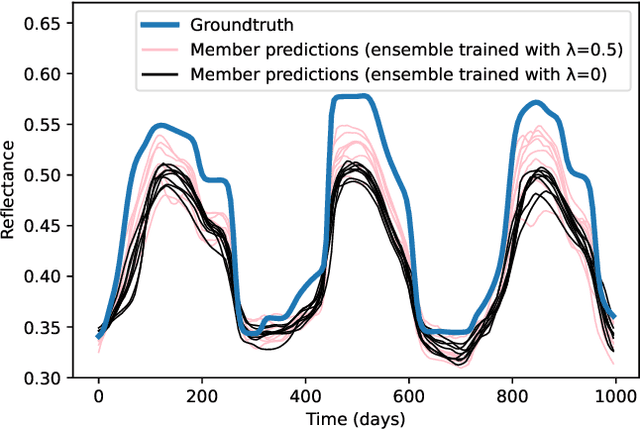
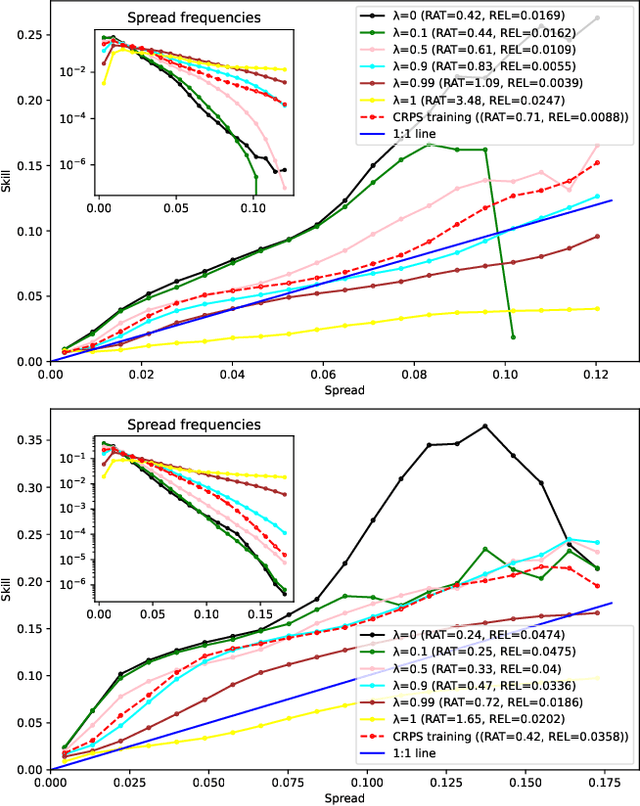
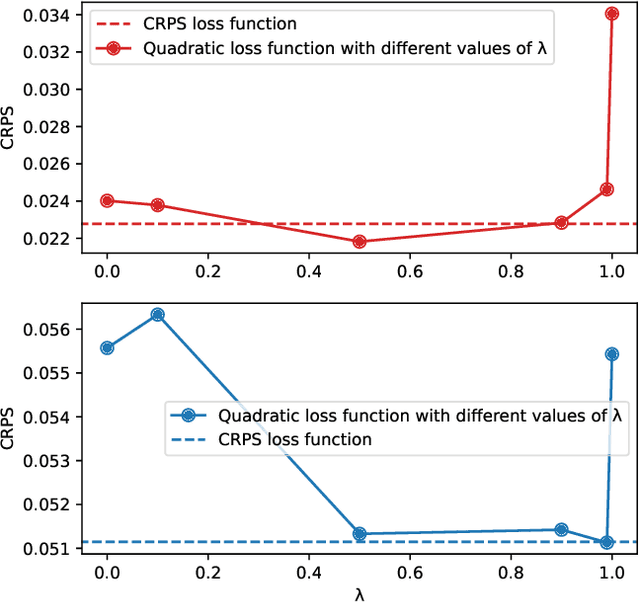
Abstract:In the context of an increasing popularity of data-driven models to represent dynamical systems, many machine learning-based implementations of the Koopman operator have recently been proposed. However, the vast majority of those works are limited to deterministic predictions, while the knowledge of uncertainty is critical in fields like meteorology and climatology. In this work, we investigate the training of ensembles of models to produce stochastic outputs. We show through experiments on real remote sensing image time series that ensembles of independently trained models are highly overconfident and that using a training criterion that explicitly encourages the members to produce predictions with high inter-model variances greatly improves the uncertainty quantification of the ensembles.
MultiHU-TD: Multifeature Hyperspectral Unmixing Based on Tensor Decomposition
Oct 05, 2023Abstract:Hyperspectral unmixing allows representing mixed pixels as a set of pure materials weighted by their abundances. Spectral features alone are often insufficient, so it is common to rely on other features of the scene. Matrix models become insufficient when the hyperspectral image (HSI) is represented as a high-order tensor with additional features in a multimodal, multifeature framework. Tensor models such as canonical polyadic decomposition allow for this kind of unmixing but lack a general framework and interpretability of the results. In this article, we propose an interpretable methodological framework for low-rank multifeature hyperspectral unmixing based on tensor decomposition (MultiHU-TD) that incorporates the abundance sum-to-one constraint in the alternating optimization alternating direction method of multipliers (ADMM) algorithm and provide in-depth mathematical, physical, and graphical interpretation and connections with the extended linear mixing model. As additional features, we propose to incorporate mathematical morphology and reframe a previous work on neighborhood patches within MultiHU-TD. Experiments on real HSIs showcase the interpretability of the model and the analysis of the results. Python and MATLAB implementations are made available on GitHub.
Neural Koopman prior for data assimilation
Sep 11, 2023Abstract:With the increasing availability of large scale datasets, computational power and tools like automatic differentiation and expressive neural network architectures, sequential data are now often treated in a data-driven way, with a dynamical model trained from the observation data. While neural networks are often seen as uninterpretable black-box architectures, they can still benefit from physical priors on the data and from mathematical knowledge. In this paper, we use a neural network architecture which leverages the long-known Koopman operator theory to embed dynamical systems in latent spaces where their dynamics can be described linearly, enabling a number of appealing features. We introduce methods that enable to train such a model for long-term continuous reconstruction, even in difficult contexts where the data comes in irregularly-sampled time series. The potential for self-supervised learning is also demonstrated, as we show the promising use of trained dynamical models as priors for variational data assimilation techniques, with applications to e.g. time series interpolation and forecasting.
Model-based demosaicking for acquisitions by a RGBW color filter array
Jun 02, 2023Abstract:Microsatellites and drones are often equipped with digital cameras whose sensing system is based on color filter arrays (CFAs), which define a pattern of color filter overlaid over the focal plane. Recent commercial cameras have started implementing RGBW patterns, which include some filters with a wideband spectral response together with the more classical RGB ones. This allows for additional light energy to be captured by the relevant pixels and increases the overall SNR of the acquisition. Demosaicking defines reconstructing a multi-spectral image from the raw image and recovering the full color components for all pixels. However, this operation is often tailored for the most widespread patterns, such as the Bayer pattern. Consequently, less common patterns that are still employed in commercial cameras are often neglected. In this work, we present a generalized framework to represent the image formation model of such cameras. This model is then exploited by our proposed demosaicking algorithm to reconstruct the datacube of interest with a Bayesian approach, using a total variation regularizer as prior. Some preliminary experimental results are also presented, which apply to the reconstruction of acquisitions of various RGBW cameras.
Learning Sentinel-2 reflectance dynamics for data-driven assimilation and forecasting
May 05, 2023Abstract:Over the last few years, massive amounts of satellite multispectral and hyperspectral images covering the Earth's surface have been made publicly available for scientific purpose, for example through the European Copernicus project. Simultaneously, the development of self-supervised learning (SSL) methods has sparked great interest in the remote sensing community, enabling to learn latent representations from unlabeled data to help treating downstream tasks for which there is few annotated examples, such as interpolation, forecasting or unmixing. Following this line, we train a deep learning model inspired from the Koopman operator theory to model long-term reflectance dynamics in an unsupervised way. We show that this trained model, being differentiable, can be used as a prior for data assimilation in a straightforward way. Our datasets, which are composed of Sentinel-2 multispectral image time series, are publicly released with several levels of treatment.
The ImSPOC snapshot imaging spectrometer: image formation model and device characterization
Mar 27, 2023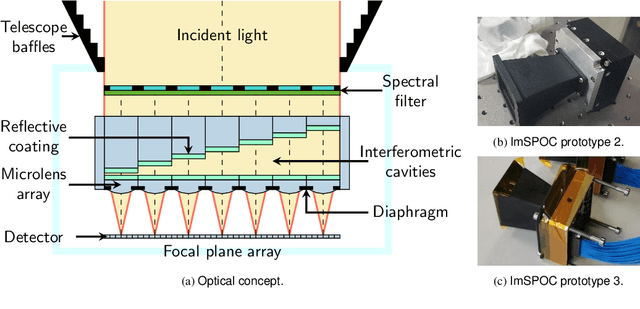
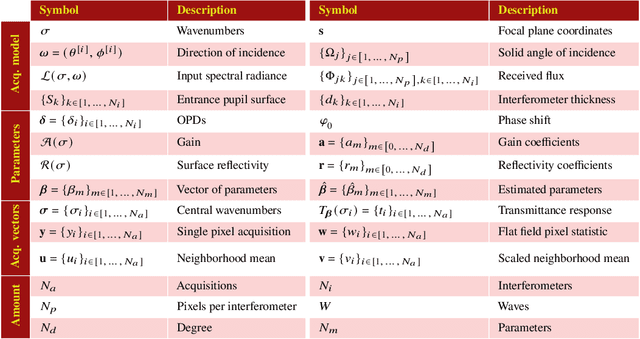
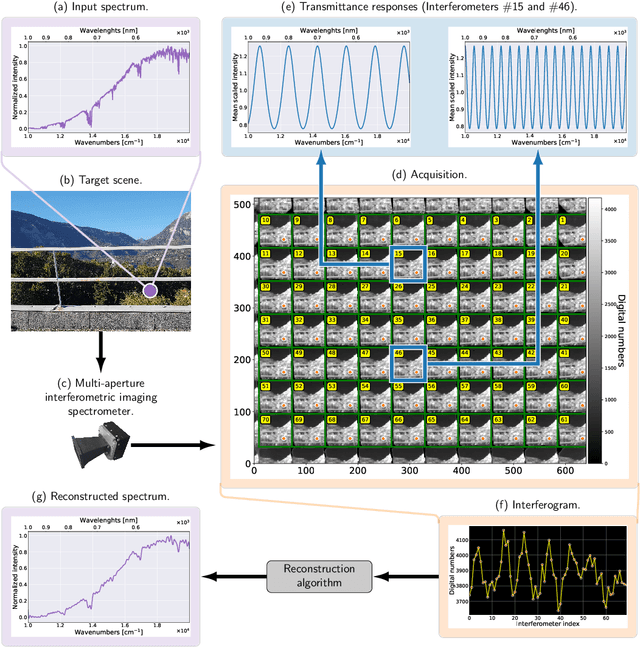

Abstract:In recent years, the demand for capturing spectral information with finer detail has increased, requiring hyperspectral imaging devices capable of acquiring the required information with increased temporal, spatial and spectral resolution. In this work, we present the image acquisition model of the Image SPectrometer On Chip (ImSPOC), a novel compact snapshot image spectrometer based on the interferometry of Fabry-Perot. Additionally, we propose the interferometer response characterization algorithm (IRCA), a robust three-step procedure to characterize the ImSPOC device that estimates the optical parameters of the composing interferometers' transfer function. The proposed algorithm processes the image output from a set of monochromatic light sources, refining the results through nonlinear regression after an ad-hoc initialization. Experimental analysis confirms the performances of the proposed approach for the characterization of four different ImSPOC prototypes. The source code associated to this paper is available at https://github.com/danaroth83/irca.
Leveraging Neural Koopman Operators to Learn Continuous Representations of Dynamical Systems from Scarce Data
Mar 13, 2023Abstract:Over the last few years, several works have proposed deep learning architectures to learn dynamical systems from observation data with no or little knowledge of the underlying physics. A line of work relies on learning representations where the dynamics of the underlying phenomenon can be described by a linear operator, based on the Koopman operator theory. However, despite being able to provide reliable long-term predictions for some dynamical systems in ideal situations, the methods proposed so far have limitations, such as requiring to discretize intrinsically continuous dynamical systems, leading to data loss, especially when handling incomplete or sparsely sampled data. Here, we propose a new deep Koopman framework that represents dynamics in an intrinsically continuous way, leading to better performance on limited training data, as exemplified on several datasets arising from dynamical systems.
 Add to Chrome
Add to Chrome Add to Firefox
Add to Firefox Add to Edge
Add to Edge